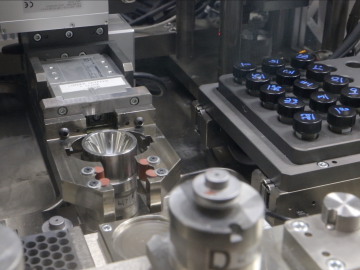
Filter News
Area of Research
- (-) Neutron Science (38)
- (-) Nuclear Science and Technology (22)
- (-) Quantum information Science (6)
- Advanced Manufacturing (3)
- Biological Systems (1)
- Biology and Environment (41)
- Building Technologies (1)
- Computational Biology (2)
- Computational Engineering (3)
- Computer Science (15)
- Electricity and Smart Grid (1)
- Energy Science (42)
- Functional Materials for Energy (1)
- Fusion and Fission (11)
- Fusion Energy (8)
- Isotope Development and Production (1)
- Isotopes (28)
- Materials (61)
- Materials for Computing (9)
- Mathematics (1)
- National Security (22)
- Nuclear Systems Modeling, Simulation and Validation (1)
- Supercomputing (125)
News Topics
- (-) Advanced Reactors (11)
- (-) Biomedical (16)
- (-) Computer Science (21)
- (-) Frontier (1)
- (-) Isotopes (5)
- (-) Physics (11)
- (-) Space Exploration (8)
- 3-D Printing/Advanced Manufacturing (10)
- Artificial Intelligence (6)
- Big Data (2)
- Bioenergy (9)
- Biology (7)
- Biotechnology (1)
- Chemical Sciences (3)
- Clean Water (2)
- Composites (1)
- Coronavirus (11)
- Cybersecurity (4)
- Energy Storage (6)
- Environment (8)
- Fossil Energy (1)
- Fusion (9)
- Grid (1)
- High-Performance Computing (2)
- Hydropower (1)
- Machine Learning (3)
- Materials (14)
- Materials Science (26)
- Mathematics (1)
- Microscopy (5)
- Molten Salt (4)
- Nanotechnology (11)
- National Security (2)
- Neutron Science (122)
- Nuclear Energy (38)
- Polymers (1)
- Quantum Computing (1)
- Quantum Science (16)
- Security (2)
- Summit (6)
- Transportation (5)
Media Contacts

Scientists have discovered a way to alter heat transport in thermoelectric materials, a finding that may ultimately improve energy efficiency as the materials

An ORNL-led team's observation of certain crystalline ice phases challenges accepted theories about super-cooled water and non-crystalline ice. Their findings, reported in the journal Nature, will also lead to better understanding of ice and its various phases found on other planets, moons and elsewhere in space.

Ionic conduction involves the movement of ions from one location to another inside a material. The ions travel through point defects, which are irregularities in the otherwise consistent arrangement of atoms known as the crystal lattice. This sometimes sluggish process can limit the performance and efficiency of fuel cells, batteries, and other energy storage technologies.

OAK RIDGE, Tenn., March 20, 2019—Direct observations of the structure and catalytic mechanism of a prototypical kinase enzyme—protein kinase A or PKA—will provide researchers and drug developers with significantly enhanced abilities to understand and treat fatal diseases and neurological disorders such as cancer, diabetes, and cystic fibrosis.


By automating the production of neptunium oxide-aluminum pellets, Oak Ridge National Laboratory scientists have eliminated a key bottleneck when producing plutonium-238 used by NASA to fuel deep space exploration.

The Department of Energy’s Oak Ridge National Laboratory is collaborating with industry on six new projects focused on advancing commercial nuclear energy technologies that offer potential improvements to current nuclear reactors and move new reactor designs closer to deployment.

A team of scientists has for the first time measured the elusive weak interaction between protons and neutrons in the nucleus of an atom. They had chosen the simplest nucleus consisting of one neutron and one proton for the study.

To learn more about interactions between drug molecules and micelles, Associate Professor Megan Robertson and graduate students Tyler Cooksey and Tzu-Han Li from the University of Houston (UH) are using neutrons at the Department of Energy’s (DOE’s) Oak Ridge National Laboratory (ORNL).
![2018-P07635 BL-6 user - Univ of Guelph-6004R_sm[2].jpg 2018-P07635 BL-6 user - Univ of Guelph-6004R_sm[2].jpg](/sites/default/files/styles/list_page_thumbnail/public/2018-P07635%20BL-6%20user%20-%20Univ%20of%20Guelph-6004R_sm%5B2%5D.jpg?itok=hUSyvkP0)
A team of scientists, led by University of Guelph professor John Dutcher, are using neutrons at ORNL’s Spallation Neutron Source to unlock the secrets of natural nanoparticles that could be used to improve medicines.


